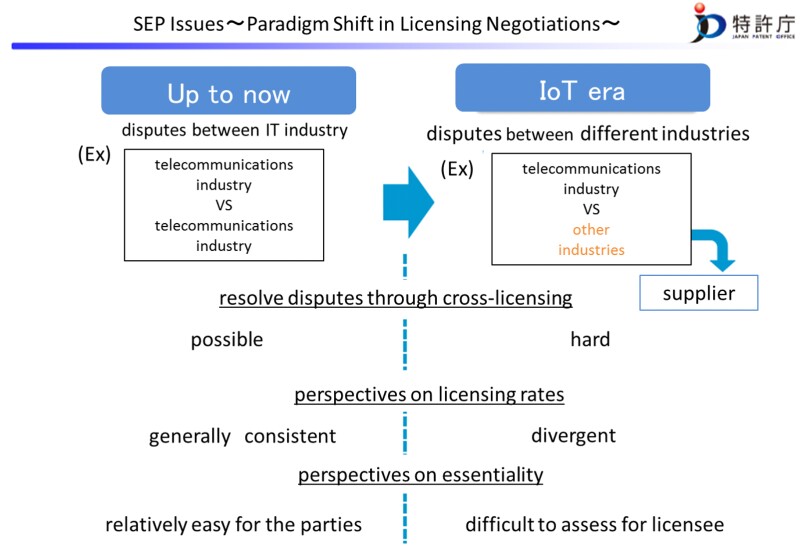
The Fourth Industrial Revolution along with the spread of the IoT means that SEP licensing negotiations are expected to be held more often between SEP holders in the information and communication technology field and business entities in industries other than the telecommunications industry, especially multi-component products industries such as automobiles, game machines etc. However, risks involving SEP licensing negotiations and disputes have been increasing significantly because licensing negotiation practices and market views on royalties are very different between the above business entities and SEP holders. Being aware of such issues, the Ministry of Economy, Trade and Industry (METI) published the Guide to Fair Value Calculation of Standard Essential Patents for Multi-Component Products (the basic concept) on April 21 2020. The basic concept has been formulated based on the report (dated March 31 2020) of the Study Group on Fair Value Calculation of Standard Essential Patents for Multi-Component Products (report), commissioned by the Policy Planning and Coordination Division, Manufacturing Industries Bureau, the METI.
Summary of the basic concept
Three principles for calculating the fair value of SEPs for multi-component products
Principle (1): The parties to a licensing agreement should be decided based on the concept of “license to all.”
The actors involved in producing a multi-component product form a hierarchical structure in which the end-product manufacturer is at the top, and the suppliers that supply parts to the end-product manufacturer exist as primary subcontractors, secondary subcontractors, etc. For this reason, who the parties to a licensing agreement should be becomes an issue in the supply chain of a multi-component product.
In this regard, it is appropriate to adopt the concept of “license to all,” which means that an SEP holder must give a licence to all entities who wish to obtain a licence, regardless of their transaction stages in the supply chain, for the following reasons.
Firstly, because SEPs are required to be “non-discriminatory” as a FRAND condition, they should not treat the potential implementers discriminately based on their transaction stages.
Secondly, in the case of multi-component products, an entity possessing detailed knowledge of the main product that implements the SEP technology exists somewhere in the supply chain. Therefore, the party to the negotiation should not be limited to the end-product manufacturer in order to calculate the royalty appropriately.
Furthermore, in cases based on the “license to all” concept, the SEP holder may claim royalties from, for example, both the supplier and the end-product manufacturer, with regard to the same SEP technology implemented in the multi-component product. In this case, the SEP holder should avoid the double gain of royalties from multiple entities in the supply chain.
Principle (2): Royalty should be calculated using a “top-down” approach.
If many SEP holders individually demand royalties, such royalties may “stack up,” making the cost for implementing the standard excessively high (royalty stacking).
A “top-down” approach which determines the appropriate rate by calculating the ratio of contribution by all SEPs to the standard can avoid this royalty stacking problem. This approach is also appropriate as it enables all SEP holders to obtain a fair share.
Principle (3): Royalty should be calculated based on the portion the SEP technology contributes (contribution rate) in the value of the main product that implements the SEP technology.
There is controversy over whether to adopt the smallest salable patent practising unit (SSPPU) or the entire market value (EMV) for the calculation of royalties.
In this regard, it is necessary to consider the further consequences of legal precedents and theories of each country, but the essential question is not whether to base the royalty calculation on SSPPU or EMV, but that it is fundamental to calculate royalties based on the portion to which the SEP technology contributes (contribution rate) in the value of the main product in which the SEP technology is implemented. In this connection, in the case of automobiles,* which can be said to be typical of multi-component products that contain many parts, the value calculated based on the contribution rate has been calculated based on the parts that essentially implement the patent concerned.
In any case, whether the basis of calculation is SSPPU or EMV, royalties that deviate significantly from the value calculated based on the contribution rate are not the fair value of the SEP.
However, if the parties do not consider the calculation based on the strict contribution rate to be practical, a simpler calculation method may be adopted, such as setting the royalty per product to a fixed amount. Even in that case, it is basically desirable that the fixed amount does not greatly deviate from the amount calculated based on the contribution rate.
* For example, an automobile is manufactured by combining approximately 30,000 (modules) complex components. In the automotive industry, there is the system of division of labour in which each supplier designs and develops its own products and is responsible for quality assurance. This system contributes to ensuring the quality of automobiles.
Practical tips
The JPO published the Guide to Licensing Negotiations involving Standard Essential Patents on June 5 2018, stating both rights holder’s arguments and implementer’s arguments regarding the above issues, but the basic concept took a stance more in line with the implementer. This shows the approach of facilitating negotiations concerning SEP disputes is becoming a major bottleneck in the process of promoting the IoT. One member of the Intellectual Property Committee Industrial Structure Council (Committee) commented on the basic concept, stating that it should be noted that the basic concept was not a final decision of the METI, but rather a conclusion of a study group of one bureau and that the JPO was not involved in the basic concept’s formulation. The Fair Standards Alliance, which is participated in mainly by automobile manufacturers and aims to promote SEP licensing subject to FRAND conditions, expressed on its website that it welcomes the basic concept.
In the report, the companies' opinions are presented. Regarding issue (1) “It is not practical for an automobile manufacturer to be responsible for every patent on the tens of thousands of components. As a patent on component, negotiating with the supplier who designs and manufactures the component and is conversant with the technology is more efficient for the SEP holder” (automobile manufacturer/ implementer). Regarding issue (2) “If the royalties on an SEP accumulate and ultimately exceed the price of the product, it is strange and must be tightly controlled” (electronic equipment manufacturer/ SEP holder, implementer). Regarding issue (3) “It is obviously incorrect to pay unexpected royalties for the provision of a beneficial service and increased added value to the end-product, which the supplier particularly could not predict, and would not be able to fulfil the patent warranty agreement” (electronic equipment manufacturer/ implementer).
In the Committee, Mr Shitara, former chief judge of the IP High Court, said he agrees with principles (2) and (3), because he understands the principles make the same points as the Apple v Samsung judgment of the Grand Panel of the IP High Court. He also stated that regarding principle (1), it would be best if a worldwide consensus could be reached and negotiations could be based on it, but it is not easy until case law is accumulated in each country. Mr Shitara also mentions that people in the IP departments of Japanese companies are overwhelmed at entering into licence agreements with many foreign SEP holders, and that a situation where more SEP holders join Avanci, offer very reasonable royalties and conclude licence agreements at the unified contact is desirable.
In January, February, and March of this year, Sharp filed three patent infringement lawsuits against Tesla Motors Japan in the Tokyo District Court on the grounds of infringing of the Long Term Evolution (LTE) patents. It will be interesting to observe whether the impact of Daimler being defeated in the Mannheim District Court and the Munich District Court in Germany, an automobile kingdom, will be recreated in Japan, also an automobile kingdom. Attention must be paid to the outcome of the lawsuit.












